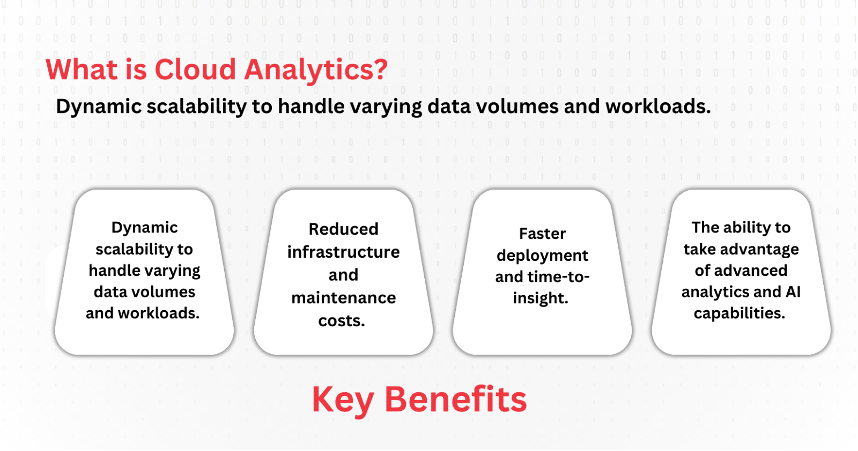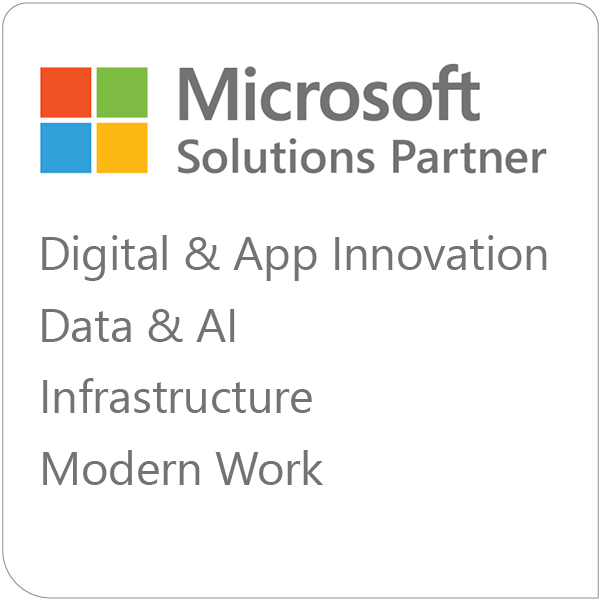Cloud analytics is the process of collecting, analyzing and deriving insights from data using cloud computing platforms and services. By leveraging the scalability, flexibility and power of the cloud, organizations can process and analyze massive amounts of data more efficiently than with traditional on-premises solutions.

The key benefits of cloud analytics include
- Dynamic scalability to handle varying data volumes and workloads.
- Reduced infrastructure and maintenance costs.
- Faster deployment and time-to-insight.
- The ability to take advantage of advanced analytics and AI capabilities.
You may also like: Maximizing the Value of Cloud Analytics and Big Data
How Cloud Analytics Works
At a high level, a cloud analytics platform consists of several key components working together. The first step is collecting data from various sources and moving it to the cloud environment. This could include structured transactional data from ERP and CRM systems, unstructured data like emails, social media posts and documents, or real-time streaming data from mobile apps, IoT sensors and clickstream logs.
For example, Unilever, the global consumer packaged goods company, pipes petabytes of sales data, digital marketing interactions, and consumer sentiment data from dozens of source systems into a centralized data lake on Microsoft Azure. They then use Azure Data Factory and Azure Databricks to cleanse, transform and aggregate the raw data at scale.
Microsoft Azure offers an end-to-end cloud analytics solution. Companies can use Azure Data Factory to ingest and transform data from on-premises and cloud sources, then store it in Azure Data Lake Storage or Azure Synapse Analytics, a distributed data warehouse that can scale to petabytes of data. They can then use Azure Databricks, an Apache Spark-based analytics platform, to process and analyze the data using machine learning and advanced analytics.
The curated data is stored in cloud-based data warehouses like Microsoft Azure Synapse Analytics or data lakes built on object storage services like Azure Data Lake Storage, which can elastically scale to handle massive volumes.
Once the data is centralized in the cloud, the real analytics muscle kicks in. Cloud platforms provide managed services for data integration, data quality, data cataloging, and powerful analytics engines that can crunch through petabyte-scale datasets with ease.
Microsoft Azure provides a rich set of similar AI and analytics capabilities. Azure Machine Learning enables data scientists and developers to build, train and deploy machine learning models at scale. Azure Cognitive Services offer pre-built AI models for common scenarios like sentiment analysis, image recognition and language translation. And Power BI, Microsoft's business intelligence platform, allows users to create interactive data visualizations and dashboards with natural language query.
Benefits of Cloud Analytics
Across industries, organizations are moving their analytics workloads to the cloud to take advantage of key benefits. One of the biggest is near-infinite scalability. Consider Qualpay, a provider of integrated omnichannel payment solutions for small and mid-sized businesses. By building their data analytics platform on Amazon Web Services, they can easily scale their storage and compute resources as their data volumes grow, without having to invest in and manage on-premises infrastructure. This allows them to focus on deriving valuable insights to better serve their customers, while keeping their IT costs under control.
Similarly, Anheuser-Busch InBev, the world's largest brewer, uses Microsoft Azure to collect and analyze over 500 billion sensor readings per year across its global manufacturing facilities. Azure's ability to elastically scale compute and storage resources enables AB InBev to combine real-time sensor data with transactional ERP data and apply machine learning to optimize production, ensure quality and reduce waste.
In fact, cost savings is another major benefit of cloud analytics. With the cloud's consumption-based pricing model, companies only pay for the storage and compute resources they use, avoiding the big upfront capital expenses and ongoing maintenance of on-premises infrastructure.
Just as important as cost savings is the agility and speed to market that cloud analytics enables. Instead of waiting weeks or months to provision hardware and configure software, a new cloud data warehouse or Spark cluster can be spun up in minutes. Analytics teams are freed from infrastructure management to focus on value-added analysis and insight delivery.
You may also like: 7 Reasons Why You Should Use Azure For Software Development
Common Use Cases
This agility is powering cloud analytics use cases across industries and business functions. In healthcare, Humana is using Microsoft Azure to integrate data across its member touchpoints, clinical interactions, and provider network. By building a unified data platform on Azure, they can apply advanced analytics and machine learning to personalize member recommendations, improve healthcare outcomes, and reduce costs.
In retail, Walgreens Boots Alliance, a global pharmacy and healthcare company, built a cloud-native data platform on Azure to drive customer-centric marketing, optimize supply chain and enable new healthcare services. They leverage Azure Synapse Analytics to process over 200 million transactions per week, powering personalized omnichannel experiences.
And in manufacturing, Rockwell Automation built a scalable IoT platform on Azure to help its customers monitor and optimize industrial equipment and processes. Streaming data from millions of connected devices is ingested using Azure IoT Hub and processed in real-time with Azure Stream Analytics, enabling predictive maintenance and remote asset management.
Other Microsoft customers are also achieving transformative results with cloud analytics on Azure. Majid Al Futtaim, a leading retail and entertainment conglomerate in the Middle East, Africa and Asia, used Azure Synapse Analytics and Power BI to unify data across its business lines and build an enterprise-wide analytics platform. This enabled them to optimize inventory, personalize customer engagement, and launch new data-driven businesses. H&R Block, a leading tax preparation company, used Azure and Power BI to reimagine the tax filing experience, combining data from 20 million tax returns with third-party data sources to provide personalized insights to customers.
Getting Started with Cloud Analytics
If you're not using cloud analytics today, getting started is easier than you might think. The first step is selecting the right cloud analytics platform for your needs. Leading cloud providers like Microsoft Azure, AWS, and Google Cloud, Snowflake and Databricks all have compelling offerings, but they each have their strengths and tradeoffs.
Key considerations include performance at scale (concurrency, query speed), breadth of analytics and AI/ML services, quality of migration and ETL tools, ecosystem of technology partners, security and compliance certifications, and total cost of ownership. Many organizations pursue a multi-cloud strategy to avoid lock-in and tap the best capabilities of each platform.
The next step is migrating existing data and analytics assets to the cloud. For "lift and shift" migrations of large datasets, cloud providers offer secure offline transfer appliances like AWS Snowmobile, Azure Data Box and Google Transfer Appliance that can move petabytes of data. Online services like AWS Database Migration Service, Azure Data Factory and Snowflake SnowMirror enable continuous replication of on-premises data to the cloud.
But successful cloud migrations require more than just copying data. Analytics processes and workloads like data integration pipelines, BI data models and dashboards also need to be rebuilt for the cloud. The best approach is to start with a small, high-impact use case to build momentum and validate the target architecture, then iterate and scale over time.
Ultimately, building a successful cloud analytics capability requires aligning people, processes and technology around data-driven decision making. Companies need to invest in data literacy and self-service analytics tools to empower business users. They need DataOps practices to ensure data quality and governance at scale. And they need an agile, business-focused delivery model to drive adoption and measure ROI.
Conclusion
Cloud analytics is leveraging the power of data to drive innovation and competitive advantage like never before. By providing near-infinite scale, elastic computing and advanced analytics services, the cloud is making it possible for organizations to extract insight from the massive volumes of data they generate every day.
And with the right strategy and execution, any company can harness this potential and become a truly data-driven enterprise. It starts with identifying high-impact use cases, picking the right technology platform and migration approach, and focusing on change management to drive adoption. With those elements in place, the opportunities are limitless - from optimizing operations and personalizing customer experiences to launching entirely new business models and revenue streams.
Frequently Asked Questions
What does a cloud analyst do?
A cloud analyst evaluates, implements, and optimizes cloud-based solutions to enhance organizational efficiency and performance. They specialize in leveraging cloud technologies to meet business objectives and improve scalability.
What is the difference between cloud analytics and cloud computing?
Cloud analytics focuses on analyzing and interpreting data stored in the cloud to derive insights, while cloud computing involves delivering various computing services over the internet, including storage, databases, and applications.
Which benefits are achieved using cloud analytics?
Cloud analytics provides benefits such as scalability to handle large datasets, cost-efficiency by eliminating the need for on-premises infrastructure, real-time insights for informed decision-making, and improved collaboration through shared data access.
Which features are included in a cloud analytics tool?
Cloud analytics tools typically include features like data visualization to present insights visually, predictive modeling for forecasting trends, real-time data processing for immediate analysis, and integration capabilities to connect with various data sources.
What is an example of cloud analytics?
Google Analytics exemplifies cloud analytics, offering web traffic analysis, user behavior insights, and performance metrics for websites and mobile apps using data stored in the cloud.





